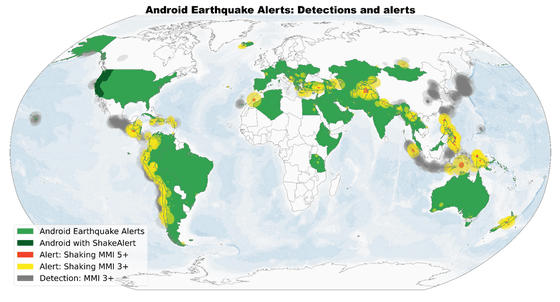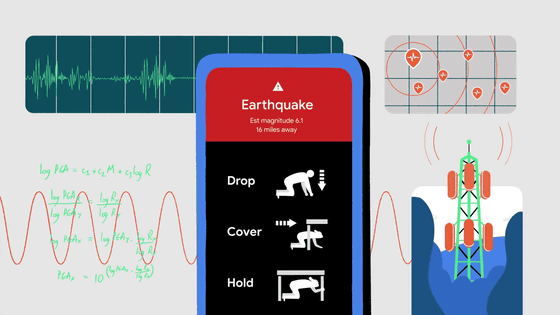Thanks to the Android Earthquake Warning System, which uses the Android smartphone network, 2.5 billion people can now receive early earthquake warnings

Google has been operating the 'Android Earthquake Warning System' since 2021, which uses the accelerometer of Android smartphones to detect high-speed seismic waves and
Android Earthquake Alerts: A global system for early warning
https://research.google/blog/android-earthquake-alerts-a-global-system-for-early-warning/
Global earthquake detection and warning using Android phones | Science
https://www.science.org/doi/10.1126/science.ads4779
Google tapped billions of mobile phones to detect quakes worldwide — and send alerts
https://www.nature.com/articles/d41586-025-02278-3
Earthquake early warning systems rely on real-time analysis of waves detected by nearby seismic stations or smartphone accelerometers. Although the sensitivity is low, smartphones are showing promise for detecting earthquake waves, especially in areas without seismic stations.
Google is actually using this system. When the accelerometer installed in an Android smartphone detects the P-waves, which are the fastest-traveling seismic waves, it sends rough information about the location of the earthquake to an earthquake detection server. After analyzing the information collected from many devices and confirming that an earthquake has occurred, it estimates the location and magnitude, and issues a warning to as many people as possible before the S-waves, which are slower but have stronger vibrations, arrive.
The Android Earthquake Warning System, which is made up of Android devices, began service in New Zealand and Greece in April 2021. By the end of 2023, it had expanded to 98 countries. To date, it has detected a total of more than 18,000 earthquakes, ranging from small earthquakes of magnitude 1.9 to large earthquakes of magnitude 7.8, and issued 790 million alerts to smartphones around the world.
The map below shows the service area, with the areas colored green being areas subject to warnings. Of these, yellow areas have been warned of weak shaking of MMI (modified Mercalli seismic intensity scale) 3 or more, and red areas have been warned of strong shaking of MMI 5 or more. Shaking of MMI 3 or more has also been detected in grey areas.

As of the end of 2019, the number of people with access to various earthquake early warning systems was about 250 million, but thanks to the addition of the Android earthquake warning system, the number of people who can receive the warnings has increased to 2.5 billion. Below is a graph showing the number of people with access to earthquake early warning systems, with the Android earthquake warning system in green.

In addition, how well the Android earthquake warning system works is that in the case of an earthquake that occurred in the Philippines in November 2023, the first warning was sent 18.3 seconds after the start of shaking, and people in the areas with the strongest shaking received a warning of up to 15 seconds, and people in areas with moderate shaking received a warning of up to 1 minute. The number of people who received the warning reaches 2.5 million.
Similarly, an earthquake in Nepal in November 2023 triggered more than 10 million alerts, and an earthquake in Turkey in April 2025 triggered more than 11 million alerts.
By the way, 1.5 million pieces of feedback were received from users, of which 85% were 'useful.' When asked when they received the warning, 36% of respondents said 'before the shaking,' 28% said 'during the shaking,' 23% said 'after the shaking,' and 13% said 'I don't know.'
Related Posts:
in Note, Posted by logc_nt







